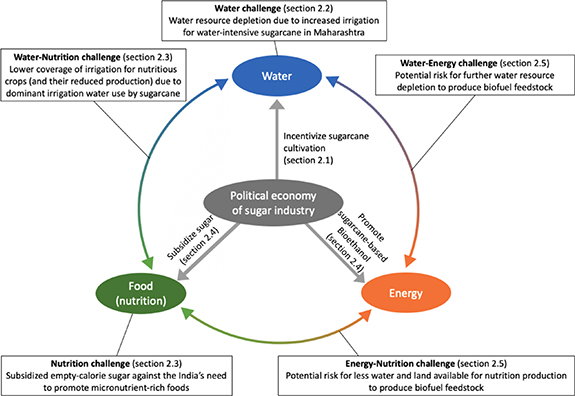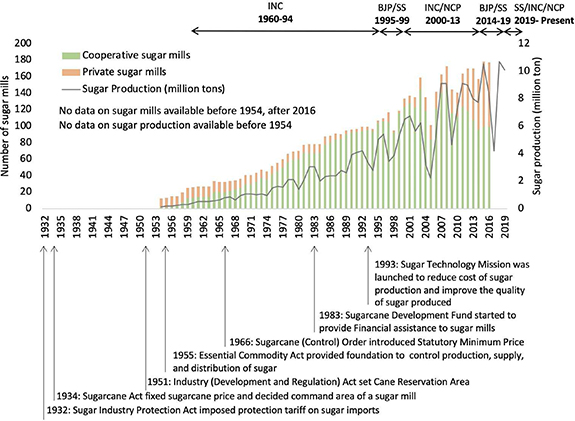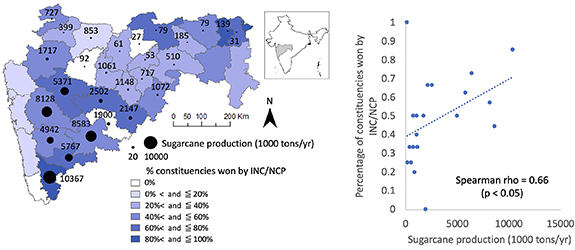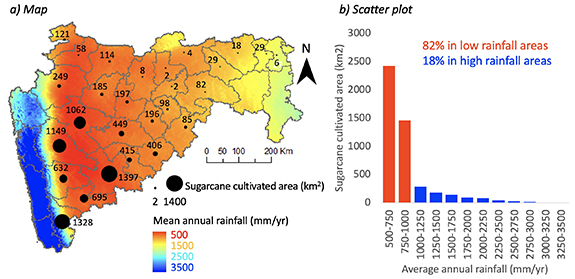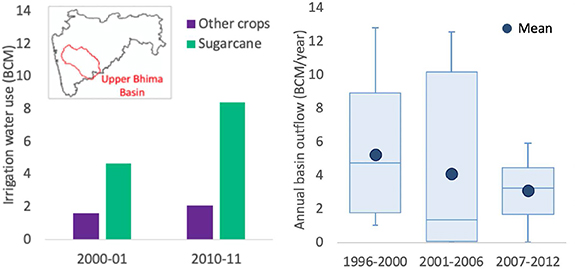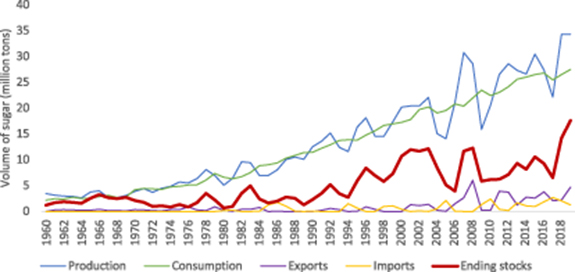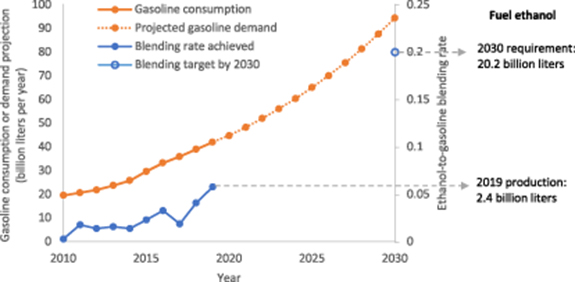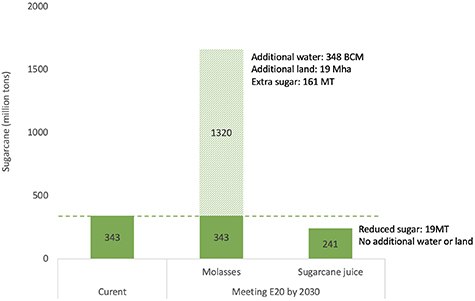Abstract
Sugar is the second largest agro-based industry in India and has a major influence on the country's water, food, and energy security. In this paper, we use a nexus approach to assess India's interconnected water-food-energy challenges, with a specific focus on the political economy of the sugar industry in Maharashtra, one of the country's largest sugar producing states. Our work underscores three points. First, the governmental support of the sugar industry is likely to persist because policymakers are intricately tied to that industry. Entrenched political interests have continued policies that incentivize sugar production. As surplus sugar has been produced, the government introduced additional policies to reduce this excess and thereby protect the sugar industry. Second, although the sugar economy is important to India, sugar policies have had detrimental effects on both water and nutrition. Long-standing government support for sugarcane pricing and sales has expanded water-intensive sugarcane irrigation in low-rainfall areas in Maharashtra, which has reduced the state's freshwater resources and restricted irrigation of more nutritious crops. Despite its poor nutritional value, empty-calorie sugar has been subsidized through the public distribution system. Third, the Indian government is now promoting sugarcane-based ethanol production. This policy has the benefit of providing greater energy security and creating a new demand for surplus sugar in the Indian market. Our analysis shows that a national biofuel policy promoting the production of ethanol from sugarcane juice versus directly from molasses may help reduce subsidized sugar for human consumption without necessarily expanding water and land use for additional production of sugarcane.
Export citation and abstract BibTeX RIS
1. Introduction and approach
India is the second largest producer and largest consumer of sugar in the world [1]. With decades of various government supports, the sugar industry is highly regulated and the second largest agro-based industry (after the textile industry) in India [2]. The industry plays an important role in the Indian economy, accounting for 1% of the national GDP and supporting over 6 million farmers plus numerous workers in harvest, transport, distribution, and wholesale [3]. Furthermore, India has over 550 sugar mills and closely related secondary industries [3].
India now faces a sugar paradox: on one hand, the government supports the production of both sugarcane and sugar with financial incentives and price supports; on the other hand, the government spends billions of dollars to remove surplus sugar. These conflicting actions, resulting from the political economy of the Indian sugar industry, have led to interconnected water-food-energy challenges experienced nationally and locally in major sugar producing Indian states. Local impacts are exemplified in Maharashtra, one of the leading sugar-producing states, which produces about one-third of India's sugar and 5% of the world's sugar (2010–2019 average) [1, 4]. In Maharashtra, expansion of water-intensive sugarcane depletes the state's water resources and reduces irrigation and production of other nutritious crops. Meanwhile, the government subsidizes empty-calorie sugar against the country's nutritional goals. The government also promotes sugarcane-based bioethanol, which can enhance energy independence but also further strain water and land resources by expanding production of sugarcane feedstock.
Over the past decade, research on the water-food-energy nexus has been conducted in many areas of the world and is now widely accepted as a field of study to build new understanding of the interconnectivity among these three resources [5–8]. This field of research provides critical knowledge for coordinated management to improve the security and sustainability of water-food-energy systems [5–7]. Although water-food-energy nexus studies often assess the role of government policies on resource use, few focus on the influence of the political economy—that is, how policymakers have entrenched economic interests in the industry they govern [9]. Existing studies provide partial accounts of the water-food-energy nexus in India based on the role of minimum support prices for wheat and rice and flat-tariffs for agricultural electricity; together, the studies demonstrate how those policies lead to unsustainable use of groundwater, over-production of those crops at the expense of high-value and more nutritious crops, and acute financial instability of electric utilities [10–13].
There has been no study that comprehensively assesses the water-food-energy challenges specific to India's sugar industry in the context of its political economy. Academic literature has addressed the political economy of the sugar industry in Maharashtra and in India [14–18] but not its relationship with water-food-energy security holistically. The media and NGOs often attribute water security problems in Maharashtra to the control of water by politicians who own sugar mills [19–21]; however, their analysis is incomplete because it does not address the connections with food and energy security or the more complex ways that the government has supported the industry.
Our approach to studying water-food-energy challenges in Maharashtra consists of two methods. First, we use the nexus approach that examines the latest available data and literature to arrive at new insights into the links, feedbacks, and tradeoffs within the water, food, and energy system. Second, we analyze the water-food-energy dynamics through a political economy lens, which incorporates a careful review of the history of political and economic incentives surrounding the sugar industry, as well as an assessment of contemporary policies [22–24]. Combining these approaches permits us to develop a narrative around the water-food-energy nexus; although lacking causal attribution, this approach provides an economic and behavioral context for understanding the persistent challenges across India's resource sectors.
As shown in figure 1, this paper discusses the following major themes: what interconnected water, food, and energy challenges arise from the sugar industry and how the political economy drives the challenges. Table 1 summarizes the spatial scales used and our rationale for their selection. We use specific spatial scales that are suitable for analysis of the political economy and of each challenge. Although using a single spatial scale would simplify the exposition, it would fail to capture some linkages that exist at different spatial scales. Section 2 assesses the nexus challenges and discusses the role of the political economy (sub-section details in figure 1), and section 3 concludes with main take-aways from this paper and future directions for this line of research.
Figure 1. Water-food-energy nexus driven by the political economy of the sugar industry in India. Government policies supporting the sugar industry contribute to regional water depletion, poor nutrition, and biofuel expansion that relies on scarce land and water resources.
Download figure:
Standard image High-resolution imageTable 1. Spatial scales for the nexus challenges and political economy analyzed in this paper. Water-food-energy challenges are experienced at different spatial scales, and the government policies driving the challenges are at national and state levels. This paper discusses each challenge and the political economy at the suitable spatial scale.
| Spatial scale | Components | Rationale |
|---|---|---|
| India | Political economy, Nutrition challenge, Energy-Nutrition challenge | Several national policies support the sugar industry (e.g. subsidized sugar, biofuel). Although sugarcane production is limited to a few states, the final products of sugar and biofuel are traded and consumed across India, affecting national nutrition and energy security. |
| Major sugar producing states | Energy-Water challenge | Although India's biofuel policy is a national one, the additional sugarcane required for biofuel will likely be produced in major sugar producing states, where the political economy will likely further encourage the industry. The additional water necessary will come from local sources and affect local water security. |
| Maharashtra state | Political economy, Water-Nutrition challenge | Maharashtra, a major sugar producing state, offers a good example of how the sugar industry has gained political power. State policies support the sugar industry (e.g. favorable policies to sugar cooperatives) and regulate irrigation water use for different crops. |
| Upper Bhima Basin | Water challenge | The Upper Bhima Basin, a major sugarcane producing region in Maharashtra, is a watershed of great interest because it has significant area planted with sugarcane and for which we have available data sufficient to address hydrologic impacts (e.g. reduction in river baseflow). |
2. Water-food-energy challenges and political economy
2.1. Government supports for the sugar industry driving water and nutrition challenges
India's sugar industry, which took off under government protection in 1932, has rapidly grown under the long-standing government supports from the 1950s through the present. The government has used various interventions to support the entire value chain of the sugar industry: guaranteed sale1 and minimum price for sugarcane, financial assistance to sugar mills (especially cooperatives), monthly releases of sugar in free markets to regulate sugar price (abolished in 2012), and subsidized sugar provided to consumers [14]. These government supports for the sugar industry, which were initiated to enhance rural development after Indian Independence was achieved in 1947, have persisted due to consolidation of political power during the sugar industry's growth.
Maharashtra presents an excellent example of how the sugar industry gained political power. Since the 1950s, the state's policies favored the promotion of sugar cooperatives [15]. These cooperatives enabled sugarcane farmers to become shareholders in their regional sugar mill. The cooperatives played a critical role in rural development by creating employment at sugar mills and subsidiary industries as well as building schools, colleges, and hospitals [16]. As sugar cooperatives became important to the rural economy, their board chairmen and directors, who were elected by cooperative member farmers, gained considerable prestige and patronage [17]. With the status and power of sugar cooperative board members, major political parties began recruiting them into local and state politics [17, 18]. In turn, sugar cooperatives made contributions to political election campaigns of their board members, and those elected became 'sugar baron' politicians, who continued government support for the sugar industry [18].
Overall, sugar mills and politicians created a symbiotic relationship that had a reinforcing cycle [15]. This relationship, especially between sugar cooperatives and the Congress Party is evident: 74% of the chairmen of sugar cooperatives were elected as members of the Legislative Assembly and Parliament during the 1952–1972 period [17]. This strong rural support from the sugar cooperatives has enabled the Congress Party to dominate state politics in Maharashtra [17]. Since the late 1990s, some financially unhealthy cooperative mills were liquidated and converted to private mills, and new private mills were additionally established [18, 25, 26]. However, these private sugar mills are also in the hands of the 'sugar baron' politicians who either own or indirectly control them [18].
Figure 2 shows that the number of sugar mills and sugar production in Maharashtra have rapidly increased since the 1950s.2 Over this period, the Congress Party was in power except for short interruptions and introduced various supports for the sugar industry. Figure 3 shows that the districts with a larger sugar industry tend to show stronger support for the Congress Party.
Figure 2. Interconnectedness between major ruling party in Maharashtra state government, the number of cooperative and private sugar mills (under operation) and sugar production in Maharashtra, and key supports/legislation to support the sugar industry. Since the Maharashtra government was established in 1960, the Congress Party (INC) alone (1960s–1990s) or with its splinter NCP (2000s–2010s) has mostly dominated the state government and continued the legacy of government support for the sugar industry that started in 1932. Under continued government support, sugar production and the number of sugar mills in Maharashtra have increased on trend since the 1950s. Political party acronyms: INC: Indian National Congress (the Congress party); NCP: Nationalist Congress Party; BJP: Bharatiya Janata Party; SS: Shiv Sena. Note on political parties: Having split from the INC in 1999, the NCP was also led by strong sugar interests and often formed an alliance with the INC. In contrast to INC and NCP, which have developed a symbiotic relationship with sugar mills and strong vote base in rural areas, BJP and SS have a traditional vote base in urban areas. In recent years, BJP and SS are also making inroads to rural areas developing connections with the sugar sector. Source: Sugarcane production from [4, 25, 26]; Number of sugar mills from [25, 26]; Key supports/legislation from [27]; Major ruling party from [28].
Download figure:
Standard image High-resolution imageFigure 3. District-level relationship between the level of sugarcane production (average of 1998–2018) and the support for the INC. (Indian National Congress; the Congress Party) or its splinter NCP (Nationalist Congress Party) in the 2019 Legislative Assembly election in Maharashtra: (a) on the Maharashtra district map and (b) in a scatter plot. Districts with major sugarcane production (>130 000 tons per year, which is the lowest quartile) tend to support the INC. or NCP. Both parties are led by strong sugar interests and often form a political alliance. Source: Sugarcane production from [29]; Author's aggregation of the 2019 election results at constituency level from [28] to district level (supplemental material 1 (available online at stacks.iop.org/ERL/15/084020/mmedia) for constituency level data).
Download figure:
Standard image High-resolution imageTo date, the strong sugar lobby from the coalition of sugarcane farmers, sugar mills and 'sugar-baron' politicians ensures continued support for the sugar industry, including a minimum price and guaranteed sales of sugarcane to sugar mills. As a result, sugarcane has become the most profitable crop in Maharashtra [30] (supplemental material 2). Based on our informal interviews with farmers and local agricultural experts, it appears that there are several reasons in addition to high returns why farmers prefer sugarcane: sugarcane requires less labor, can be grown in soil with some degree of toxicity (e.g. heavy metals), and can withstand longer watering intervals.3 However, sugarcane's stable high profitability, particularly relative to alternative crops, remains an important incentive for its cultivation.
2.2. Water resource depletion
Sugarcane is a water-intensive perennial crop, and the varieties grown in Maharashtra require 1700–2400 mm irrigation per growth cycle of 11–17 months [31]. Sugarcane has expanded particularly in dry Western Maharashtra, taking advantage of irrigation infrastructure and electricity subsidies for pumping groundwater. Because the basaltic (hard-rock) aquifer in Maharashtra has limited groundwater storage [32], groundwater resources alone are often insufficient to irrigate sugarcane. Therefore, sugarcane is grown in or near cultivable command areas (CCAs),4 tapping primarily surface water from canals, rivers, and reservoirs, and secondarily groundwater (figure 4). Decades of rapid growth of sugarcane cultivation and irrigation have increased pressure on the state's water resources.
Figure 4. Sugarcane cultivated area in the rabi (winter) season in Maharashtra in 2005. Sugarcane is mainly cultivated in areas with canal water access in Western Maharashtra. Source: Sugarcane cultivated area in the rabi (winter) season in Maharashtra in 2005 (the latest year with available data at pixel level) from [33]; Cultivable command areas in Maharashtra from National Hydrology Program in India.
Download figure:
Standard image High-resolution imageIn 2010–11, sugarcane, which occupied only 4% of total cropped areas, consumed 61% of irrigation water use.5 Indeed, during the past half century, sugarcane production in Maharashtra has increased seven-fold from an average of 11 million tons in the 1960s [25] to 75 million tons in most of the 2010s (2010–2018) [29], mainly through expanding areas of sugarcane cultivation (supplemental material 3). Along with area expansion, sugarcane has continued to rely on flood irrigation [34], thereby leading to a rapid increase in irrigation water use. From 1970–71 to 2010–11 irrigation water use by sugarcane has increased faster than any other crop and dominated irrigation water use in Maharashtra (figure 5).
Figure 5. Irrigation water use by major crops or crop groups in Maharashtra from 1970–71 to 2010–11. In Maharashtra, irrigation water use by sugarcane has increased more rapidly than any other crop over time, and sugarcane has used the highest share of total irrigation water in all time periods. Source: Authors' calculations (supplemental material 4 for data, assumptions, and calculations).
Download figure:
Standard image High-resolution imageGeographically, farmers cultivate sugarcane mainly in low-rainfall areas of Western Maharashtra, taking advantage of surface water storage and canal irrigation infrastructure. Such infrastructure, which was initially established in Western Maharashtra to fight droughts and famines in the early 20th Century [35], opened opportunities for irrigated agriculture and allowed expansion of sugarcane there [15, 35]. Due to the perishable nature of sugarcane, sugar mills were developed there as well. As the sugar mills gained political connections, Western Maharashtra benefited from a higher rate of irrigation development, which further enabled sugarcane cultivation [36].
In addition, sugarcane farmers also disproportionately benefit from electricity subsidy for groundwater pumping. This agricultural subsidy was implemented in Maharashtra in 1977 as a flat tariff mainly to improve billing efficiency [37]. At present, unmetered agricultural pumps get charged a flat rate tariff based on the pump capacity, and metered agricultural pumps are charged a subsidized volumetric rate tariff lower than the production cost of electricity.6 While the subsidy encouraged use of electricity for both surface water and groundwater pumping, it particularly encouraged groundwater use, giving farmers more access to and control of water. The subsidy substantially reduced the irrigation costs, which was particularly beneficial for water-intensive sugarcane. Also, the comparatively well-off sugarcane farmers were financially better able to drill wells and invest in irrigation infrastructure (i.e. pumps) and take advantage of subsidized electricity [37].
Rapid expansion of sugarcane and dominant water use to irrigate sugarcane in the low-rainfall areas has raised concerns regarding water scarcity and allocation in Maharashtra. In 1999, the Maharashtra Water and Irrigation Commission recommended that sugarcane should be banned in areas that received less than 1000 mm rainfall per year [38], and many water experts have repeated similar recommendations [3]. Nevertheless, 82% of sugarcane cultivation falls in regions with low-rainfall (<1000 mm/year) where farmers have access to surface water irrigation (figure 6).
Figure 6. Comparison of mean annual rainfall to sugarcane cultivated area: (a) district-level sugarcane cultivated area (average of 2007–2018) on the Maharashtra rainfall map (average of 2007–2018) and (b) sum of pixel-level sugarcane cultivated area (2005; 500 m resolution) by rainfall levels in a bar plot. Sugarcane is mostly grown in low-rainfall districts in Maharashtra that have less than 1000 mm rainfall per year, which is the minimum annual rainfall for sugarcane cultivation recommended by the government. Note that the Western Ghats, a mountainous range, creates the large disparity in rainfall distribution between the westernmost districts and the rest of the state. More details about our analysis for this figure and additional analysis of sugarcane production versus rainfall can be found in supplemental material 5. Source: District-level sugarcane cultivated in 2007–2018 from [27]; Sugarcane cultivated area in the rabi (winter) season in Maharashtra in 2005 from [33]; Map of mean annual rainfall in 2007–2018 from [39].
Download figure:
Standard image High-resolution imageTo analyze the hydrologic impact of sugarcane, we examine the case of the Upper Bhima Basin. The region is a watershed of great interest because it has significant area planted with sugarcane, and data from the Basin show hydrologic impacts of increasing sugarcane irrigation. From 2000 to 2010, the Upper Bhima Basin saw a substantial increase in irrigation water use for sugarcane and a marginal increase for other crops (figure 7(a)). Accordingly, the Basin's outflow was reduced from 1996 to 2012 (figure 7(b)). Our analysis of groundwater heads during 1996–2016 shows no statistically significant long-term decline in groundwater levels in the Basin (supplemental material 6). However, over the long term, groundwater levels are likely to decline once a new hydrologic equilibrium is reached, which can take decades. Currently, the impact of groundwater depletion appears as a reduction in baseflow of rivers and short-term drying of wells during droughts.
Figure 7. Analysis of the Upper Bhima Basin: (a) irrigation water use by sugarcane and other crops in 2000–01 and 2010–11 and (b) annual river outflow averaged over three time periods (1996–2000, 2001–2006, and 2007–2012) showing a similar precipitation level (36, 35, and 37 BCM, respectively). In the Upper Bhima Basin, sugarcane irrigation has substantially increased from 2000–01 to 2010–11, while irrigation has marginally increased for other crops. As sugarcane irrigation has increased, the average river basin outflow has decreased over the similar period. Source: (a) Irrigation water use: author's calculations (supplemental material 4 for data, assumptions, and calculations); (b) river outflow: data from the basin simulation office located in Pune, Maharashtra.
Download figure:
Standard image High-resolution image2.3. Reduced production and consumption of nutritious crops
India's leading nutritional challenges today are protein and micronutrient deficiencies [40, 41]. Micronutrients are required in small amounts but essential to human health; their deficiency can lead to illness, disabilities, and even death [42]. India faces micronutrient deficiency in iron, vitamin A, vitamin B12, vitamin C, folate, iodine, zinc, and copper [41, 43]. For example, the most common form of micronutrient deficiency in India, anemia caused by iron deficiency, afflicts roughly 50% of preschool children and contributes to 70% of maternal deaths [41, 44, 45].
The sugar industry worsens nutrition insecurity in two ways. First, our work in Maharashtra shows that the dominant water use to cultivate sugarcane prevents irrigation and production of other crops that contain protein and micronutrients. Although Maharashtra has the largest number of dams in India [46], much of the developed irrigation potential is being diverted to cultivate sugarcane. This diversion, in turn, has forced less water-consumptive, nutritious food crops largely into rainfed areas, showing much lower irrigation coverage than the national average. Cereals and pulses grown in Maharashtra generally require 300–800 mm of water [47], which is still less than the water requirement for sugarcane when adjusted for their shorter growth periods. Nonetheless, as of 2013–14, irrigation coverage of cereals and pulses was only 22% and 12% in Maharashtra, compared to 60% and 20%, respectively, in India overall (figure 8). Only 19.6% of Maharashtra's cropped area is irrigated, less than half of the national average of 47.7% [48]. Consequently, nutritious food crops, left to be grown under rainfed conditions, not only suffer from low yields but also remain vulnerable to variability in the timing and intensity of monsoons [48, 49]. Although households can purchase protein and micronutrient-rich food produced in other states, local production is important for household nutritional outcomes, especially in remote rural areas in India where transportation infrastructure and supply chains are poorly developed [50, 51].
Figure 8. Percentage coverage of irrigated area under principal crops, 2013–14. In Maharashtra, cereals, pulses, and oilseeds are significantly less irrigated than the national average in order to irrigate water-intensive sugarcane. Source: [48].
Download figure:
Standard image High-resolution imageThe second way that the sugar industry affects nutrition is that the Indian government encourages sugar consumption by providing it at a subsidized price through the public distribution system (PDS).7 Sugar provides high but 'empty' calories with no nutritional value (figure 9). Since the 1950s, sugar has been subsidized through the PDS in India [52]. At that time, India had experienced frequent famines, and the most pressing food security challenge was to meet basic calorie requirements [53]. In that context, PDS sugar may have been beneficial in providing cheap calories. Since then, India has greatly improved its provision of calories through growth in wheat and rice production associated with the Green Revolution in the 1960s and 70s and with subsequent agricultural policies [53]. In today's India, calorie intake is broadly sufficient across income groups, but micronutrient deficiency remains a widespread problem [53]. Nonetheless, PDS continues to distribute subsidized sugar but does not include other crops high in micronutrients and protein such as pulses and legumes. Given that the PDS provides an incentive to purchase relatively low-cost sugar over more expensive, nutritious crops outside of the system, the program does not solve India's current nutrition challenge. Instead, the PDS helps to support sugar demand, indicative of the sugar industry's strong political influence.
Figure 9. Micronutrient content and calories of sugar and selected crops. Sugar provides empty calories with no nutritional value. Source: Micronutrient content from [54] and calories from [55].
Download figure:
Standard image High-resolution imageThe PDS shifted from a universal system to one that targets only the poor in 1997 [52] but still distributes a large amount of sugar to a number of beneficiaries at a large social cost. In 2016–17, the PDS provided about 2.7 million tons of sugar to 400 million beneficiaries throughout India or approximately 30% of the country's total population [56]. Over the same period, the Indian government spent around 45 billion rupees (640 million USD8) on sugar subsidies for the PDS, accounting for 4.3% of total food subsidies [57]. Between 2004–05 and 2011–12, sugar consumption rose for lower income groups, mostly from the increase in their PDS sugar consumption [58, 59]. Although other factors also contribute to India's overall increasing sugar consumption (e.g. rising GDP per capita and greater consumption of sugary drinks), the PDS sugar program continues to play an important role at the expense of public financial resources and the nutrition of lower income groups.
2.4. Sugarcane-based ethanol production
In addition to electricity subsidy for groundwater pumping, another link of energy to the water-nutrition challenge is sugarcane-based ethanol production. India's long-term dependency on foreign oil continues to rise with escalating fuel demands as the economy develops [60]. By 2030, India's population will reach 1.5 billion, and the country is expected to have 430 million vehicles on the road [61]. To increase its energy self-reliance, the Indian government launched the Ethanol Blending Petrol (EBP) Program in 2003 [62]. Not coincidentally, this policy was introduced at the time when the sugar industry began to face new financial challenges.
After decades of growth, India's sugar industry faced substantial surplus sugar production and increasing sugar stocks by the 1990s (figure 10). Because the Indian sugar industry is highly subsidized, the domestic sugar price in India has consistently been higher than the world sugar price, making India's surplus sugar uncompetitive in the international market (supplemental material 7) [3]. This surplus sugar has led to the decline in the real sugar price in India (supplemental material 7). Meanwhile, the agricultural sector's share of income and labor in India has declined due to more balanced growth in non-agricultural sectors resulting from urbanization and industrialization. At this stage, the Indian government had two options on the sugar industry's future: either 'reduce' or 'protect' it. Due to vested political and economic interests in the sugar industry, the government has chosen the latter approach, consistent with the process of structural transformation experienced in virtually all large agricultural producing countries [63]. While continuing to support over-production of sugarcane and sugar, the government has adopted several measures to remove the surplus, such as subsidizing sugar exports and promoting PDS sugar. Introducing sugarcane-based ethanol through the EBP served the dual purpose of enhancing energy security and propping up the sugar industry by providing a diversified source of income to sugar mills and removing surplus sugar.
Figure 10. Sugar stock growth and production, consumption, and trade trends in India (1960–2018). Sugar stock in India has substantially increased from the 1990s (see footnote 2 for the cyclical fluctuations of sugar production). Source: [1].
Download figure:
Standard image High-resolution image2.5. Risks and opportunities of sugarcane-based ethanol in India
There are many examples in India and around the world of energy policies negatively affecting water and food resources. The electricity subsidy for agriculture in northern India has depleted groundwater, threatening food production [13]. Corn-based biofuel in the United States has inflated the price of corn for food and fodder [64], and ethanol policies in Brazil have incentivized the expansion of sugarcane cultivation at the expense of some staple food crops [65]. In India, sugarcane-based ethanol may also worsen the water and nutrition challenges highlighted above by requiring more water and land resources to cultivate additional sugarcane. There may be an opportunity, however, to limit the water-food downsides of bioethanol in India. If implemented properly, diverting sugar to ethanol production could improve energy self-reliance and reduce subsidized sugar consumption without having to increase sugarcane cultivation.
Under the EBP, the mandatory blending rate of ethanol with gasoline for public Oil Marketing Companies (OMCs) increased from E5 (5% ethanol) in 2008 to E20 (20% ethanol) in 2017 [66]. The highest blending rate achieved by 2017, however, was 3.3% (E3) due to insufficient ethanol production capacity, competing demands for potable and industrial ethanol, and noncompetitive pricing for fuel ethanol [67]. In 2018, the government extended the E20 target year to 2030 [68]. By 2030, India's gasoline demand is projected to increase to 94 billion liters of pure gasoline (figure 11). Given that ethanol provides 40% less energy content (density) than gasoline [69], when the two are blended more of this blended fuel is required than pure gasoline to provide the same total energy. Meeting India's gasoline demand in 2030 will require 101 billion liters of E20 blended gasoline, which will require 20 billion liters of ethanol, an increase of over eight times its current production. To reach this target, the government has introduced several new measures, such as providing financial assistance to sugar mills to enhance ethanol production capacity and raising fuel ethanol prices for the OMCs [69].
Figure 11. Gasoline consumption (2010–2019) and demand projection (2020–2030) with ethanol-to-gasoline blending rate achieved (2010–2019) and targeted by 2030. The government is aiming to increase the ethanol-to-gasoline blending rate from the current 5.8% to 20% by 2030. Since gasoline demand is projected to grow fast by 2030, achieving the target blending rate of 20% will require a substantial increase in ethanol production. Source: Gasoline consumption and blending rate in 2010–2019 from [70]; Gasoline demand projection for 2020–2026 from [71]; Gasoline demand projection for 2027–2030 extrapolated using the same percentage increase from the 2020–2026 data.
Download figure:
Standard image High-resolution imageThe most important measure introduced recently allows the use of sugarcane juice in ethanol production, in addition to molasses (a by-product from sugar processing with less extractable sugar remaining9), which was permitted previously [68]. This measure has enabled the sugar industry to divert some sugarcane juice from sugar production to ethanol production. To incentivize such diversion, the government has also set differential pricing for ethanol produced from molasses and sugarcane juice, where the price of ethanol from sugarcane juice is set higher [69]. As a result of these measures, the blending rate of ethanol grew to 5.8% in 2019, but ethanol was still largely produced from molasses [70].10 It requires investments and time, however, for distilleries to modify ethanol production to use sugarcane juice as a feedstock. Also, the availability of sugarcane juice for ethanol production is affected by sugar demand in any given year. Though the share of raw materials in ethanol production in future years is somewhat unpredictable, ethanol production is likely to grow under the government measures aimed at achieving E20 by 2030.
Although E20 is a desirable goal for improved energy security, India's biofuel policy should also be assessed for its impacts on water-food challenges. In particular, it is important to ask: How much sugarcane is required to meet India's biofuel E20 mandate by 2030, and what will be the consequences for water resources and nutrition? To assess the potential range of such impacts, we consider two future scenarios of ethanol production: continuing the current practice of heavily relying on molasses or entirely switching to sugarcane juice.
The first scenario of continuing to rely on molasses presents significant risks to India's water and nutrition challenges through additional demand placed on sugarcane. Meeting E20 with ethanol produced from molasses by 2030 would require an additional 1320 million tons of sugarcane, 348 billion m3 of water, and 19 million hectares of land in India (figure 12); or approximately 385% increases over their respective current level (2010–2018 average) assuming current average yields and water use rates for sugarcane in India (see supplemental material 8). These increases in water and land resources for sugarcane could intensify competition for these resources for nutritious crops and would further deplete water resources. Although it is possible to grow the additional sugarcane in new areas where water resources are not constrained, the political interests already established in Maharashtra and other major sugarcane producing states would likely keep sugar production mainly in those regions. At the same time, the increased sugarcane supply would lead to production of an additional 161 million tons of sugar, which is only slightly less than the world's current sugar output. Since adding this much sugar to the international market would cause the sugar price to plummet, the Indian government would need to further subsidize Indian sugar to be exported or consumed via the PDS. If put into the PDS, the extra sugar produced could encourage more consumption of empty-calorie sugar, which counters India's nutritional challenge of micronutrient deficiency.
Figure 12. Meeting E20 by 2030: additional sugarcane, water and land resources needed, and extra sugar produced. Meeting the 20% ethanol-to-gasoline blending rate by 2030 with ethanol produced from molasses would require additional water and land resources and produce extra sugar. In contrast, ethanol produced from sugarcane juice could meet the blending target without risking water and land resources and would reduce extra sugar. Source: Authors' calculations (supplemental material 8 for data, assumptions, and calculations).
Download figure:
Standard image High-resolution imageThe other scenario of ethanol production from sugarcane juice presents an interesting possibility of meeting E20 without having to increase sugarcane supply and with the nutritional benefits of reducing PDS sugar. The current level of sugarcane production is sufficient to supply the amount of ethanol needed to meet E20 by 2030 if ethanol comes entirely from sugarcane juice (figure 12). Therefore, water resource depletion and competition for water and land resources for nutritious crops would at least not worsen further. In addition, using sugarcane juice for bioethanol could reduce sugar production by 19 million tons per year, which is more than the current stock of surplus sugar in India. By removing some of this surplus sugar, the government would be able to reduce spending on its export subsidy and PDS sugar. Nevertheless, a reduction in government spending would likely be minimal, since subsidies for ethanol development would be required. However, removing surplus sugar could help reduce the amount of subsidized PDS sugar and promote consumption of more nutritious crops that are needed to attain nutrition security in India. Such nutritional benefits would not occur if ethanol were made predominantly from molasses.
3. Discussion and conclusion
To summarize, we have shown how the sugar industry in India presents interconnected water-food-energy challenges that are locally experienced in Maharashtra, a major sugar-producing state, and more broadly in India. Our analysis adds to the existing literature on India's water-food-energy nexus, which focuses primarily on wheat and rice, and demonstrates how the political economy of the sugar industry perpetuates distortions in all three resource sectors. Focusing on the political economy dimensions of the water-food-energy nexus helps to clarify the root causes and future trajectory of India's resource challenges.
Our paper highlights three main conclusions. First, entrenched political interests have long supported the sugar industry in Maharashtra through various policies, including guaranteed prices and sale for sugarcane and public distribution of sugar. Policies supporting the sugar industry are unlikely to disappear in Maharashtra, since the policymakers and the 'sugar barons' are often one and the same. Second, although the sugar industry has played an important role in the Indian economy, government sugar supports have had widespread repercussions in the water and food sectors. Price supports and guaranteed sales to sugar mills have incentivized farmers to expand cultivation of water-intensive sugarcane in low-rainfall areas in Maharashtra, depleting the state's freshwater resources and restricting irrigation of more nutritious crops. By maintaining its subsidized sugar through the public distribution system, the government has also promoted the consumption of empty-calorie sugar. And third, a new policy for sugarcane-based bioethanol, if implemented wisely, could enhance energy self-reliance and reduce subsidized sugar for human consumption. Specifically, using sugarcane juice as opposed to molasses as a feedstock for ethanol could help meet energy targets without requiring additional water and land resources for sugarcane production. This approach would likely reduce surplus sugar and eliminate the need for public distribution of sugar.
Future research is needed to develop a systems model to quantify and simulate water-food-energy interactions of the sugar industry in India. Such a model can be used to evaluate future policy options that point the way for India to achieve water-food-energy sustainability. Our study provides a useful foundation for development of such a policy evaluation model by providing insights regarding which policy options might be feasible given the entrenched political and economic interests in the industry. Key to model utility is a deep understanding of the political economy that enables a more realistic analysis of future trajectories of interconnected water-food-energy systems.
Acknowledgments
This work was supported by US National Science Foundation (NSF) grant ICER/EAR1829999 to Stanford University under the Belmont Forum Sustainable Urbanisation Global Initiative (SUGI)/Food-Water-Energy Nexus theme. Any opinions, findings, and conclusions or recommendations expressed in this material do not necessarily reflect the views of the NSF. We also thank Yoshihide Wada, Sudatta Ray, Philip Womble, Abigail Nora Birnbaum and Steven Seungkyun Ko for providing valuable comments.
Data availability statement
The data that support the findings of this study are available from the corresponding author upon reasonable request. Summary streamflow data is presented in the paper, and raw streamflow data can be obtained upon request from the Basin Simulation Office located in Pune, Maharashtra in India.
Footnotes
- 1
Through Cane Area Reservation that puts sugar mills and sugarcane farmers in a contractual relationship to ensure adequate supply of sugarcane to sugar mills.
- 2
The cyclical swings in sugar production are caused by natural factors such as droughts and pest problems and also induced by government regulations. Government regulations supporting sugarcane production result in a glut of sugarcane and sugar production, thereby depressing the sugar price. This lower sugar price leads to reduced profitability for sugar mills and delayed payments to sugarcane farmers. As the sugarcane arrears increase, farmers switch to other crops. Then, sugarcane and sugar production decreases, followed by higher sugar prices, higher profitability and lower arrears, and the cycle repeats [3].
- 3
Sugarcane's tolerance to water stress is important given the high variability in seasonal rainfall and canal water operations.
- 4
Cultivable command area is defined as the area which can be irrigated from canals and is fit for cultivation.
- 5
The Report on Sugarcane Price Policy in 2014–15 states that sugarcane consumes 71.5% of total irrigation water in Maharashtra [32], but their calculation does not include fruits and vegetables. See supplemental material 4 for more details for our calculations.
- 6
The Maharashtra State Electricity Distribution Co. Ltd. serves 3.7 million Agriculture consumers, out of whom approximately 2.2 million are unmetered [37].
- 7
The PDS distribute food and non-food commodities, such as wheat, rice, sugar, and kerosene, to India's poor at subsidized rates [52].
- 8
For this calculation, the average exchange rate in 2019, 71 Indian rupees/USD, is used.
- 9
Two types of molasses are used for ethanol production: molasses-C and molasses-B. Molasses-C is a final by-product from sugar processing with no economically extractable sugar remaining, and molasses-B is an intermediate by-product with some extractable sugar remaining.
- 10
Out of 2400 million liters (ML) of bioethanol produced in 2018–2019, 1800 ml (75%) was produced from molasses-C, 420 ml from molasses-B (18%), 20 ml (1%) from sugarcane juice, and 160 ml (7%) from damaged food grains [66].



